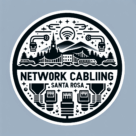What Is L1, L2, and L3 Wiring? A Simple Guide to Electrical Phases and Connections
If you’ve ever looked at an electrical panel or wiring diagram and noticed labels like L1, L2, and L3, you might wonder what they mean. These terms are essential in both residential and commercial electrical systems. Understanding them helps you identify how power flows, how circuits are divided, and why three-phase wiring is commonly used in industrial and commercial settings. Our experienced team of structured cabling specialists in Santa Rosa provides safe and efficient wiring solutions for both commercial and residential applications.
Understanding the Basics of L1, L2, and L3 Wiring
L1, L2, and L3 represent the live or phase wires in an electrical system. They carry current from the power source to the electrical equipment or load. The exact meaning depends on whether the system is single-phase or three-phase:
- L1 and L2 are typically found in single-phase systems, such as residential homes.
- L1, L2, and L3 are used in three-phase systems, which are common in industrial and commercial buildings.
Each “L” stands for a Line, meaning a conductor carrying alternating current (AC). Together, these lines provide a consistent and balanced supply of power.
Single-Phase vs. Three-Phase Wiring
To better understand how L1, L2, and L3 work, it helps to look at the difference between single-phase and three-phase wiring systems.
Single-Phase Wiring (L1 and L2)
- Found in most homes and small offices
- Uses two wires: one live (L1) and one neutral
- Operates at 120V or 240V, depending on your region
- Suitable for lighting, outlets, and standard appliances
Three-Phase Wiring (L1, L2, and L3)
- Used in commercial, industrial, and large building applications
- Uses three live wires plus a neutral (and sometimes a ground)
- Delivers more consistent power and supports heavy electrical loads
- Operates typically at 208V, 400V, or 480V, depending on configuration
In a three-phase system, each line (L1, L2, and L3) carries an alternating current that’s 120 degrees out of phase with the others. This setup provides smoother and more efficient power delivery, especially for motors and large electrical systems.
Why L1, L2, and L3 Wiring Matters
Understanding the role of L1, L2, and L3 wiring is crucial for safe and efficient electrical work. Here’s why it’s important:
- Safety: Correctly identifying each line prevents electrical faults and short circuits.
- Performance: Proper phase balance ensures equipment runs efficiently.
- Maintenance: Knowing the phases simplifies troubleshooting and system upgrades.
- Compatibility: Helps when connecting new systems like generators or UPS units.
Where L1, L2, and L3 Wiring Are Commonly Used
You’ll encounter these line designations in various settings, including:
- Residential systems: L1 and L2 for standard power supply
- Commercial buildings: L1, L2, and L3 for HVAC units, elevators, and lighting systems
- Industrial facilities: Machinery, pumps, motors, and control panels
- Renewable energy setups: Three-phase wiring in solar inverters and wind turbines
Common Misunderstandings About L1, L2, and L3
Let’s clear up a few misconceptions:
- They’re not the same as neutral or ground. L1, L2, and L3 are live lines; the neutral wire returns current to complete the circuit.
- Color codes vary by region. For example, in the U.S., phase wires are usually black, red, and blue, while in Europe, they may be brown, black, and gray.
- They don’t all carry the same voltage to ground. Depending on the configuration, each phase’s voltage may differ when measured to neutral.
Tips for Working Safely with L1, L2, and L3
Electrical wiring should always be handled by qualified professionals, especially when dealing with multiple phases. Here are some essential safety practices:
- Turn off power at the main breaker before any work.
- Use proper tools like multimeters for phase identification.
- Label all wires clearly during installation or maintenance.
- Follow local electrical codes such as the California Electrical Code (CEC) or NEC (National Electrical Code).
- Hire a licensed electrician for installations or troubleshooting involving three-phase systems.
The Future of Electrical Wiring
With the growing demand for renewable energy, electric vehicles, and smart home technologies, electrical systems are becoming more advanced. Three-phase wiring (L1, L2, L3) continues to be a reliable standard for managing higher power demands in both commercial and industrial applications.
Understanding how these lines work ensures that your system remains safe, efficient, and ready for future energy needs. To understand more about specific wire categories, check out our detailed guide on what Type 2 wire is.
Final Thoughts
L1, L2, and L3 wiring may sound technical, but the concept is simple once you break it down. They represent the lines or phases that deliver electricity to your home or business. Whether you’re setting up a new electrical system or maintaining an existing one, knowing what these designations mean can help you make smarter, safer decisions.
For complex wiring, upgrades, or troubleshooting, always consult a certified electrician familiar with California electrical standards to ensure your setup is compliant and efficient.
